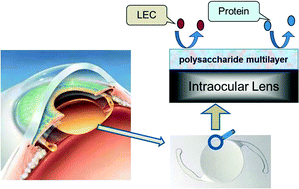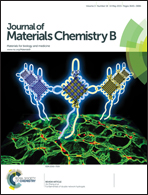Hydrated polysaccharide multilayer as an intraocular lens surface coating for biocompatibility improvements
Abstract
Posterior capsule opacification (PCO) is a significant complication of intraocular lens (IOL) implantation in cataract surgery, in which the adhesion and proliferation of lens epithelial cells (LECs) on the IOL surface play important roles. In the present study, a highly swollen hyaluronic acid (HA)/chitosan (CHI) polyelectrolyte multilayer was fabricated on the IOL surface via the layer by layer technique. Quartz crystal microbalance with dissipation (QCM-D) results not only show the successful construction of the multilayer, but also indicate its hydrogel-like swollen property. The water content of the (HA/CHI)5 multilayer is around 400%, as obtained by thermogravimetry (TG) analysis. Compared with a pristine IOL, the polysaccharide multilayer modification does not influence its optical property, whereas the adhesion and proliferation of LECs are greatly inhibited. In vivo ocular implantation results show that such a polysaccharide multilayer modification presents good in vivo biocompatibility, and has positive effects on reducing PCO development.


 Please wait while we load your content...
Please wait while we load your content...